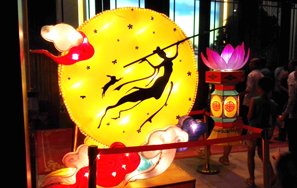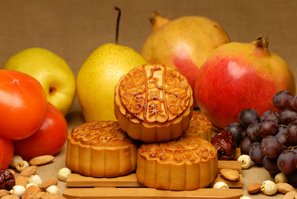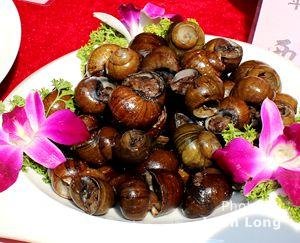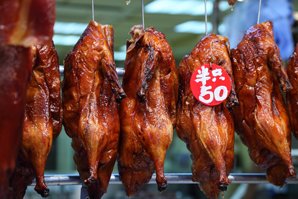
A 3-Day Short Trip Peak Time Appears
Chinese people will have a three-day "public holiday" on the 15th and 17th — a normal weekend off for 5-day week workers, however...
When Mid-Autumn occurs at the end of September or early October its statutory day of public holiday is usually combined with the statutory National Day three-day holiday for a seven-day public holiday (October 1–7), sacrificing one adjacent weekend day ( for example, in 2015 people need to work on Saturday, October 10).
Date of Mid-Autumn Day in the Coming Years
| Years | Dates | Day |
|---|---|---|
| 2016 | September 15 | Thursday |
| 2017 | October 4 | Wednesday |
| 2018 | September 24 | Monday |
| 2019 | September 13 | Friday |
| 2020 | October 1 | Thursday |
| 2021 | September 21 | Tuesday |
| 2022 | September 10 | Saturday |
Mid-Autumn falls as early as September 8 (2033) and as late as October 6 (2025) in the next 30 years.
Why Mid-Autumn Is Celebrated at Month 8 Day 15
Mid-Autumn Festival celebration
Traditional Calendar Seasons
According to the Chinese lunar calendar (and traditional solar calendar), the 8th month is the second month of autumn. As the four seasons each have three (about-30-day) months on the traditional calendars, day 15 of month 8 is "the middle of autumn".
For the Full Moon
On the 15th of the lunar calendar, each month, the moon is at its roundest and brightest, symbolizing togetherness and reunion in Chinese culture. Families get together to express their familial love by eating dinner together, appreciating the moon, eating mooncakes, etc. The harvest moon is traditionally believed to be the brightest of the year.
For Harvest Celebration
Month 8 day 15, is traditionally the time rice is supposed to mature and be harvested. So people celebrate the harvest and worship their gods to show their gratitude.
 Mooncakes are the most important food of the Mid-Autumn Festival in China.
Mooncakes are the most important food of the Mid-Autumn Festival in China.

The Mid-Autumn Festival or Moon Festival dates back over 3,000 years, to moon worshiping in the Shang Dynasty (1600–1046 BC).
As well as the history below, there are several legends that explain the origin of China's Mid-Autumn Festival in a more fanciful way.
Sacrificing to the Moon
— Earliest Origins as Ancient Worship
Ancient Chinese emperors worshiped the harvest moon at Mid-Autumn, as they believed that the practice would bring them a plentiful harvest the next year.
Sacrificing to moon has various names in different regions of China. It is called ‘worshiping the moon’ in Suzhou of Jiangsu Province, ‘thanking peace’ in Zhenjiang of Jiangsu Province, ‘paying respect to the moon palace’ in Zhenghe of Fujian Province, ‘making wishes to the moon’ in Zhongmou of Henan Province, and ‘worshiping moonlight’ in Sihui of Guangdong Province.
The word 'mid-autumn' first appeared in Zhou Dynasty literature. During that time, worshiping the moon on the 15th night of the eighth month had spread to high officials and rich families. The practice entailed placing a large table in the middle of the yard under the moon, and they put offerings such as fruits and snacks on the table.
The custom of offering sacrifices to the moon originates from worshiping the lunar goddess, and it was recorded that kings offered sacrifices to the moon in fall during the Western Zhou Dynasty (1045–770 BC). Sacrificing to the moon was very popular in the Song Dynasty (960–1279), and become a custom ever since.
The sacrificial offerings include apples, plums, grapes, and incense, but mooncakes and watermelons (pomelos in the south) are essential. The watermelon’s (pomelo's) skin is sometimes sliced and opened up into a lotus shape when offered as a sacrifice.
Appreciating the moon with family on the Mid-Autumn Festival.
Appreciating the Moon
— Harvest Moon Feasts Established in the Middle Ages
Appreciating the moon has been a custom since the Tang Dynasty (618–907). Not only the rich merchants and officials, but also the common citizens, began appreciating the moon together at that time. The rich merchants and officials held big parties in their big courts. They drank and appreciated the bright moon. Music and dances were also indispensable. The common citizens just prayed to the moon for a good harvest.
In the early Tang Dynasty the day was officially celebrated as a traditional festival. It then became an established festival during the Song Dynasty (960–1279), and has become second in popularity to the Spring Festival since the Ming (1368–1644) and Qing (1644–1911) dynasties.
Eating Mooncakes
— a later addition, helping the overthrow of Mongol occupied China
The tradition of eating mooncakes during the festival began in the Yuan Dynasty (1271–1368, a dynasty ruled by the Mongols).
At the end of Yuan Dynasty the Han people’s resistance wanted to overthrow the rule of the Mongols, so they planned an uprising, but they had no way to inform every Han who wanted to join them of the time of the uprising without being discovered by the Mongols.
 Mooncakes are the most important food of the Mid-Autumn Festival in China.
Mooncakes are the most important food of the Mid-Autumn Festival in China.
The military counselor of the Han people’s resistance army, Liu Bowen, thought out a stratagem related to mooncakes. Liu Bowen asked his soldiers to spread the rumor that there would be a serious disease in winter and eating mooncakes was the only way to cure the disease. Then he asked soldiers to write "uprising, at the night of Mid-Autumn Festival" on slips of paper, put them in mooncakes, then sell them to the common Han people.
When the night of the Mid-Autumn Festival came a huge uprising broke out. From then on, people ate mooncakes every Mid-Autumn Festival to commemorate the uprising (though this is little-remembered today).

More Interesting Articles on Mid-Autumn Festival 2016
 Lanterns of the Mid-Autumn Festival
Lanterns of the Mid-Autumn Festival Mooncake, the major food for Mid-Autumn Festival
Mooncake, the major food for Mid-Autumn Festival
must eat--
he Mid-Autumn Festival falls on the 15th day of the 8th lunar month, traditionally China's harvest time. Every home makes various delicious food and good wines to celebrate the festival. Over the centuries the rich and colorful Mid-Autumn Festival diet customs were formed. The most popular Mid-Autumn Festival foods include mooncakes, pumpkin, river snails, taro, wine fermented with osmanthus flowers, duck and hairy crabs.
Mooncake - the must-eat food
 Mooncakes
Mooncakes
Mooncake is the most popular and important food eaten during the Mid-autumn Festival. Various types of mooncakes are placed in the most prominent places in stores and markets as the festival approaches. Mooncakes are traditionally Chinese pastries which consist of a thin tender skin enveloping a sweet, dense filling. Mooncakes were used to be made at home, but very few people make them at home nowadays.
The traditional fillings include lotus seed paste, sweet bean paste and egg yolk, however, mooncakes with modern flavors such as ice cream mooncakes and chocolate mooncakes have appeared in recent years. Read more on mooncakes
Pumpkin — to bring good health
The tradition of eating pumpkin during the festival is followed by people living south of the Yangtze River.
Poor families chose to eat pumpkin during the Mid-Autumn Festival in ancient times, as they couldn't afford mooncakes. The tradition has been passed down, and eating pumpkin on the Mid-Autumn Festival night is believed to bring people good health.
An interesting legend goes that a very poor family, a couple with their daughter, lived at the foot of South Mountain. The old couples were seriously sick for lack of food and clothes. The daughter found a oval-shaped melon one day when she was working in the fields on the South Mountain. She brought the melon home and cooked to serve to her dying parents. Surprisingly, her sick parents recovered after eating the melon. Because the melon was picked from the South Mountain, so it was named 'south melon' (the Chinese name for pumpkin).
River Snails — Brighten your eyes
 Fried River Snails
Fried River Snails
Traditionally, river snails are an indispensable food for the Mid-Autumn Festival dinner for people in Guangzhou. River snails are usually cooked with medicinal herbs to dispel their unpleasant odor. Eating river snails during the Mid-Autumn Festival is believed to help brighten the eyes.
Taro — Bring good luck
Eating taro during the Mid-Autumn Festival is believed to dispel to bad lack and bring good luck and wealth. The tradition began during the Qing Dynasty (1644–1911).
Wine Fermented with Osmanthus Flowers — Happy life
Drinking wine fermented with osmanthus flowers has a long history in China. Chinese people began to drink such wine over 2,000 years ago. This wine may be preferred because the Mid-Autumn Festival is when the osmanthus flowers are in full bloom. Drinking the wine signifies family reunions and a happy life.
Duck
 Roasted Duck on sale
Roasted Duck on sale
People in East China’s Fujian Province have the tradition to cook duck with a kind of taro widely planted in the area during the Mid-Autumn Festival.
Osmanthus flowers duck (salted and baked duck) is a must-eat food for people in East China’s Jiangsu Province. This is the most famous dish of Nanjing, and has a history of over 2,500 years. The dish features crisp skin, tender meat and fat, but it is not greasy.
In West China’s Sichuan Province, people enjoy smoke baked duck. The prepared duck is put in the baked censer and baked with smoke from flaming straw. The duck is cooked when it turns brown, and is then cooked with brine to add more flavor.
 Steamed Hairy Crab
Steamed Hairy CrabHairy Crab — a Seasonal Festival Delicacy
Hairy crabs are rich in protein and amino acids. The hairy crab season is September and October. So it is a special seasonal delicacy for Mid-Autumn Festival, a highlight of the Mid-Autumn Festival reunion dinner, especially around Shanghai. See Hairy Crab — The Shanghai Delicacy Every Tourist Should Try.
No comments:
Post a Comment
thank you we will revert soon